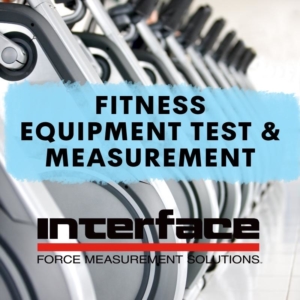Fitness Equipment Makers Require Extreme Accuracy
 Interface’s specialty is building solutions for the testing and monitoring of parts and total systems that move and create force. One of the industries where this is critical is the fitness industry. Equipment and fitness machines, whether designed for in-home use or in professional athlete training facilities, needs to perform safely and accurately.
Interface’s specialty is building solutions for the testing and monitoring of parts and total systems that move and create force. One of the industries where this is critical is the fitness industry. Equipment and fitness machines, whether designed for in-home use or in professional athlete training facilities, needs to perform safely and accurately.
Utilizing Interface sensors and instrumentation, the performance of different fitness apparatus is measured in various testing protocols throughout the product’s lifecycle. Rigorous tests are performed during each phase: R&D, design, manufacturing, and after-market use. These tests look at performance data, as well as measure reliability, durability, fatigue, and safety of the equipment. Manufacturers of fitness devices also utilize feedback from sensors to monitor user experiences in real-time. This means they need accurate data for all types of user profiles, strength variability, weights, and experience levels.
The global fitness market also needs a testing solutions partner as the industry is looking at solid growth over the next few years. In fact, Allied Market Research predicts that the fitness market will reach $14.8 billion by 2028, registering a CAGR of 3.3% year-over-year during this assessment period.
Interface recently captured a series of use cases for how our test and measurement products are used in the fitness industry for testing and in OEM applications. You can read the entire case study here: Interface Measures Fitness Equipment with Extreme Accuracy.
Addressing Challenges in Making Fitness Equipment
In the development of fitness equipment, a lot goes into the manufacturing and engineering process to ensure equipment is safe and reliable for users. Taking a treadmill as an example, the wheels that move the running surfaces must withstand varying speeds and levels of force over extended periods of time. This requires torque and stress testing. Additionally, the sensors on the handrails that send out a pulse to measure the user’s heart rate needs to provide accurate data in health and wellness uses. Manufacturers are looking to install sensors into their equipment that measure various forces and provide fitness data to the user, or data that doctors can use to monitor patients while working out. These makers and product designers for fitness equipment need sensors that can be easily designed into the product or customized to fit into existing products to enable smart functionality and IoT capabilities.
Interface Fitness Equipment Test & Measurement Solutions
Interface provides a variety of measurement solutions used by manufacturers and testing engineers in the fitness equipment sector. This includes our load cells, torque transducers, multi-axis sensors and miniature load cells, along with the popular wireless products and instrumentation. Our products have been used across a wide variety of fitness applications, including elliptical, leg press, rowing machines, bicycles both mobile and stationary, and physical training and therapy equipment. Interface sensor technologies are preferred by product design engineers in this field because of the precision, accuracy, range of options, and quality.
The following application notes examples provide an overview of how Interface serves the fitness industry:
Designing Fitness Equipment and Machines
A fitness machine manufacturer wanted multiple load measurement systems for their different fitness machines such as the elliptical, leg press, rowing machine, and the cable machines used in gyms of all types. The goal of designing sensors into the equipment is to ensure the machines are functioning properly to prevent injuries. The sensors can also be used for trainers who want to conduct strength and endurance tests. Interface provided a combination of products including the WMCFP Overload Protected Sealed Stainless Steel Miniature Load Cell, SSB Sealed Beam Load Cells, and AT103 Axial Torsion Force and Torque Transducers. Paired with Interface’s proper instrumentation, the forces can be measured, graphed, and displayed during the testing stage. Interface’s products all effectively measured forces needed for those working out or undergoing athletic training regiments. Not only did it ensure the designed machines were working properly, but it also helped those using them to track their endurance performance and consider future design enhancements based on consumer use. Read more about this use case.
Treadmill Rehabilitation
A medical device maker wanted a force measurement system for their experimental rehabilitation treadmill for patients that have pelvic mobility difficulties. For example, patients who have had strokes tend to have difficulty walking. Their goal was to measure the forces applied on the pelvis when the patient is walking on the treadmill and catch any pelvic deviations. The treadmill had a special harness with two actuators on either side of the patient when in use. Interface suggested installing two WMC Sealed Stainless Steel Miniature Load Cells to the actuators, which will measure the forces applied on the pelvis of the patient. Force results would be measured using the SI-USB4 4-Channel USB Interface Module, which could also be graphed and logged on the customer’s computer with supplied VS3 software. Using this solution, the medical company was able to catch different pelvic deviations in their experimental rehabilitation treadmill using Interface’s products. Learn more here.
Bike Power Pedals
A bike manufacturer wanted to evaluate the functionality of their power pedals. They needed a reliable system to measure how much force the cyclist pushes down onto the bike pedals, and they preferred a wireless system that can be paired with their computer to review data results. Interface suggested four Model SML Low Height S-Type Load Cells installed within the bike’s pedals. The four SMLs are paired with two WTS-AM-4 Wireless Strain Bridge Transmitter Modules, which will transmit the force data from the cyclist to the WTS-BS-6 Wireless Telemetry Dongle Base Station Dongle connected to the customer’s computer. The products Interface provided allowed the bike manufacturer to measure the pedal power applied by the cyclist. Read more here.
Interface load cells, torque transducers, and data acquisition systems are ideal for many fitness applications, especially those designed for IoT connectivity. Interface offers products that measure all types of force across the necessary fitness applications. Additionally, if we don’t have a product that works for your exact challenge, our custom solutions team will work alongside your design and test engineers to create the most effective and efficient solution based on the unique specifications.
ADDITIONAL RESOURCES
Bike Frame Fatigue Testing Application Note








